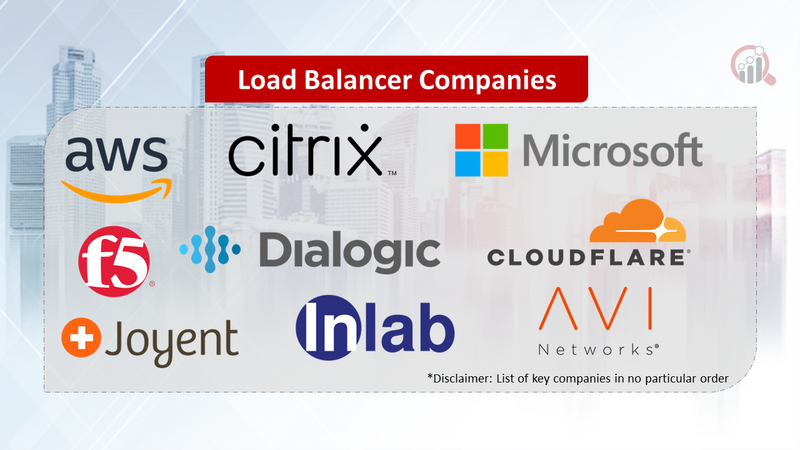Top Industry Leaders in the Load Balancer Market

Competitive Landscape of the Load Balancer Market
The load balancer market is experiencing robust growth, driven by increasing adoption of cloud-based applications, rising data center traffic, and the need for enhanced application performance and scalability. This dynamic environment fosters fierce competition among established players and opens doors for new entrants with innovative solutions. This analysis delves into the competitive landscape, highlighting key players, their strategies, market share factors, emerging companies, and current investment trends.
Key Players:
- AWS
- F5 Networks
- Citrix Systems
- Microsoft
- Dialogic
- Avi Networks
- Joyent
- Inlab Software
- Cloudflare, Inc.
- Zevenet
- Array Networks
- Avanu
- Barracuda Networks
- HPE
- IBM
- Google
- Imperva
- NGINX
- Radware
- Fortinet
- A10 Networks
- Kemp Technologies
- Riverbed Technologies
- Fastly
Strategies for Success:
- Hybrid and Multi-Cloud Support: Players are adapting to hybrid and multi-cloud environments by offering solutions that seamlessly integrate across on-premises and cloud deployments.
- Focus on Security and Automation: Integrating advanced security features and automation capabilities are crucial to attract security-conscious customers and streamline operational efficiency.
- API-Driven Development: Delivering API-driven load balancers empowers developers with programmatic control and fosters integration with DevOps pipelines.
- Focus on Emerging Technologies: Integration with containerization technologies like Kubernetes and microservices architectures is becoming essential to cater to modern application development trends.
Factors Influencing Market Share:
- Product Portfolio Breadth: Offering a diverse range of hardware, software, and cloud-based solutions caters to various needs and budgets.
- Innovation and Feature Set: Continuous innovation in algorithms, security features, and advanced functionalities attracts customers seeking cutting-edge solutions.
- Ease of Use and Integration: Integration with existing infrastructure, cloud platforms, and DevOps tools is crucial for seamless deployment and management.
- Pricing and Licensing Models: Flexible pricing models, including subscription-based options, cater to different customer segments and budgets.
- Customer Support and Service: Strong customer support and training programs enhance user experience and loyalty.
New and Emerging Companies:
- Avi Networks: Offers cloud-native load balancing solutions with advanced security features and automation capabilities.
- KEMP Technologies: Provides application delivery controllers and load balancers with a focus on ease of use and cost-effectiveness.
- Radware: Offers application delivery and security solutions with integrated load balancing functionalities.
- Volterra: Specializes in multi-cloud networking solutions with load balancing capabilities for hybrid and multi-cloud environments.
Investment Trends:
- Cloud-Based Solutions: Continued investments in cloud-native load balancing solutions are expected as cloud adoption accelerates.
- Security Integration: Integration of advanced security features and threat intelligence is a growing investment focus.
- Automation and Artificial Intelligence (AI): Investments in AI-powered automation for configuration, management, and optimization are gaining momentum.
- API-Driven Development: Facilitating programmatic control and integration with DevOps tools is attracting investor interest.
- Emerging Technologies: Investments in solutions catering to containerized environments and microservices architectures are on the rise.
Latest Company Updates:
February 6, 2024, F5 Networks announced the launch of BIG-IP 17.1, a new version of its popular load balancer platform. This version includes enhanced security features, improved performance, and better integration with cloud environments.
January 31, 2024, Citrix acquired NGINX, Inc., a leading provider of open-source load balancers and web servers. This acquisition is expected to strengthen Citrix's position in the application delivery market.
December 2023, SDLBs are gaining popularity due to their flexibility, scalability, and ease of management. Major vendors are focusing on developing advanced features like application awareness and multi-cloud support.












